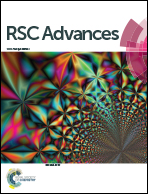Microstructured macroporous adsorbent composed of polypyrrole modified natural corncob-core sponge for Cr(vi) removal†
Abstract
A high-performance, cost-effective and spongeous adsorbent was rationally designed for Cr(VI) removal from aqueous solution based on PPy modified natural quasi two-dimensional (2D) structures. Core of corncobs, a kind of agricultural waste composed of quasi 2D sub-micro sheets, has a unique macroporous spongeous microstructure. In consideration of the unique chemical structure of polypyrrole (PPy) and microstructure of the natural sponge, we constructed the microstructured spongeous adsorbents. The PPy active layer provided reactive sizes to detoxifies Cr(VI) ions by ion-exchange. While the spongeous microstructure provided by the microsheets could enhance the adsorption performance by increasing active areas and facilitating the access of pollutants inside the adsorbents. Compared with artificial nano-powder adsorbents, CC–PPy displayed larger advantage in separation process and fabrication/operation cost. Compared with other bulk-style PPy composites, the adsorption capacity of CC–PPy was several times higher. In addition, the regeneration and stability of CC–PPy was outstanding with no loss in the adsorption to Cr(VI) even after 3 adsorption–desorption cycles. The present development provides a solution to design highly efficient and cost-effective water treatment agents.


 Please wait while we load your content...
Please wait while we load your content...